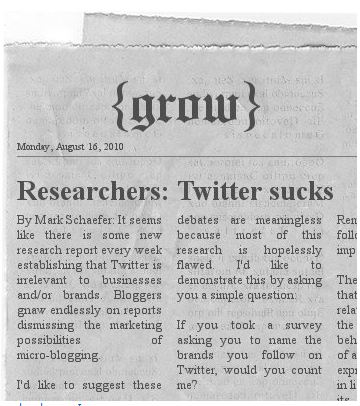
“Oh come on!” the upscale fashion retailer said. He thrust his pointed finger toward to the daily newspaper spread out next to his cash register. “Look here, here, and here,” he continued as he pointed to three different ads by three different “big box” clothing retailers or discounters. “How many ads do I have to buy to get noticed? There’s just so much clutter,” he said while he smashed the paper into a tight crumpled ball and crammed it into the trashcan.
The Problem
The retailer’s problem is the same problem facing businesses of every size. Nate Elliott, analyst for the vaunted research firm Forrester, recently turned his research prowess towards the problem. In his blog post announcing his current research project, he asked, “How can marketers overcome social clutter?” He asked readers, “Do you feel it’s getting harder or easier for marketers to get a message to users through social media?” Readers responded with an overwhelming, “harder!”
The Villain
First, let’s define this villain called Clutter. Who is this black-hatted character bringing companies large and small to their knees?
To air traffic controllers and others who read radars, clutter is “a term for unwanted echoes…[that] can cause serious performance issues…” That’s a definition marketers can visualize, too. You’ll hear communications professionals talk about the “signal to noise ratio.” Everything that’s not signal, is noise—unwanted echoes, clutter.
The Faux Solution
Many marketers attempt to overcome Clutter by buying more ad space or airtime, sending out more direct mail pieces, making more cold calls, posting more tweets or updates. Instead of killing Clutter, they feed the sneaky villain.
The Hero
Squaring off against Clutter is our white-hatted Storyteller. The Storyteller is effective not just because of what he does, but also because of who he is. Through three key relationships he’s empowered to act effectively, slicing through Clutter and delivering wanted signal.
- The storyteller’s relationship to the story: The Storyteller believes The Story is a gift that’s been given to him and a gift that increases in value as it is given away.
- The storyteller’s relationship to himself: The Storyteller is focused on The Story and minimizes self in order to present the story free of personal interference.
- The storyteller’s relationship to the audience: The Storyteller focuses on the audience and their experience of The Story. He is committed to communicating The Story to enable the audience to not only live The Story for themselves but also to co-create its meaning.
The mindset, or heart, of the Storyteller prepares him to take action to cut through Clutter.
Essential Elements
First, you need to know your own core story. Your core story is a narrative example of:
- who you are and what you stand for
- who the big, hairy monster is (the villain)
- what results customers achieve because of you
Second, you need to know your prospects’ core story. Their core story includes:
- what they want to accomplish (what results do they want in the end?)
- what gets in their way
- how they feel when they’re thwarted
- how they feel when they’re victorious
That means listening and paying attention to your prospects and customers is more important than ever. If you don’t know their stories, you won’t be able to share a story with them that cuts through Clutter.
Stories cut through clutter because, stories
- connect with people emotionally
- help us make sense of facts (facts, statements, declarations, and even offers overwhelm us; stories give us a framework to make sense of it all)
- aid memory
- aid word-of-mouth (we tend to remember in story; we tend to share in story)
Sharing your story
Adopting the mind of a storyteller, understanding your own core story, and understanding your customers’ core story are the first steps toward conquering Clutter and connecting with your marketplace. These foundational steps will take you far down the path of effective communication and engagement with the people in your marketplace.
Trey Pennington



 VERSUS
VERSUS 
